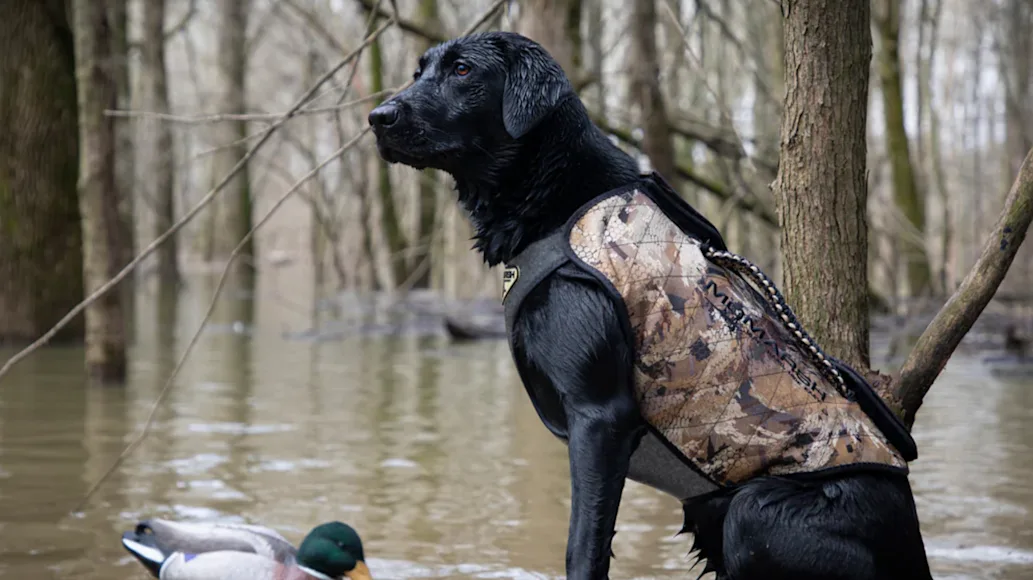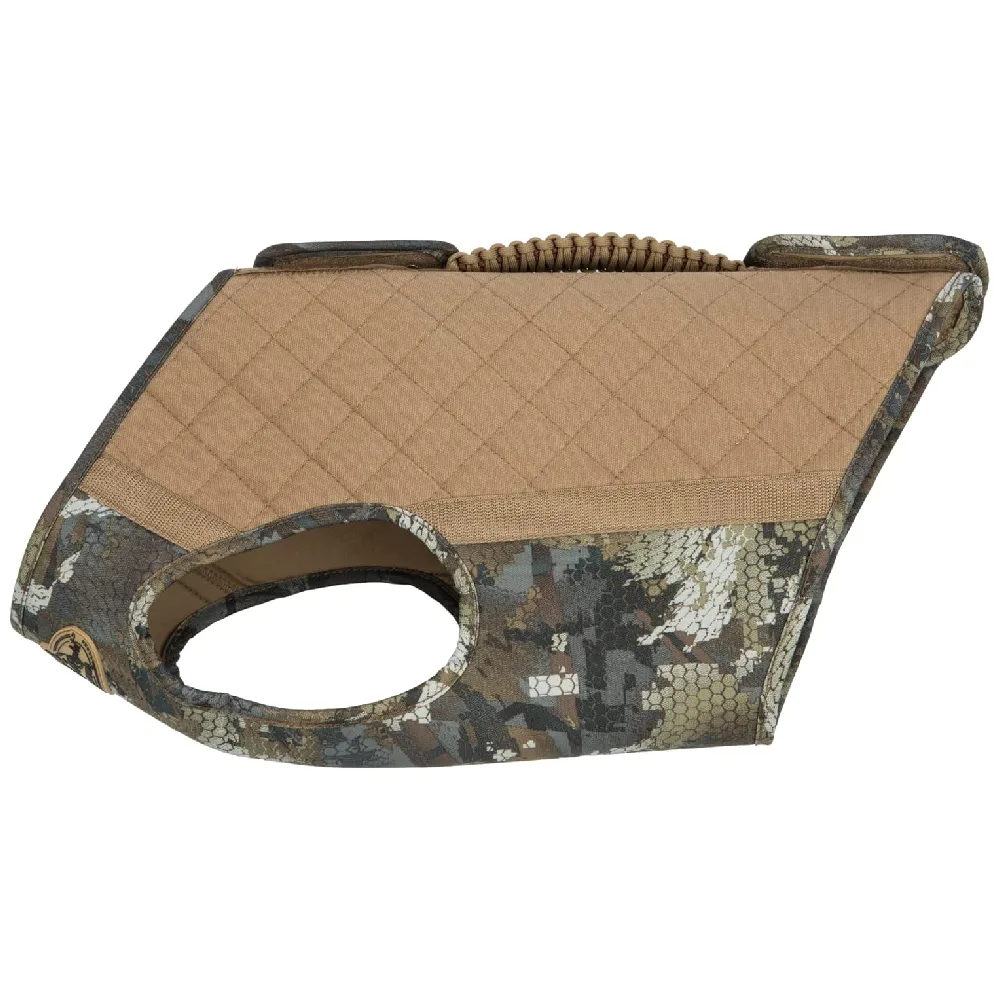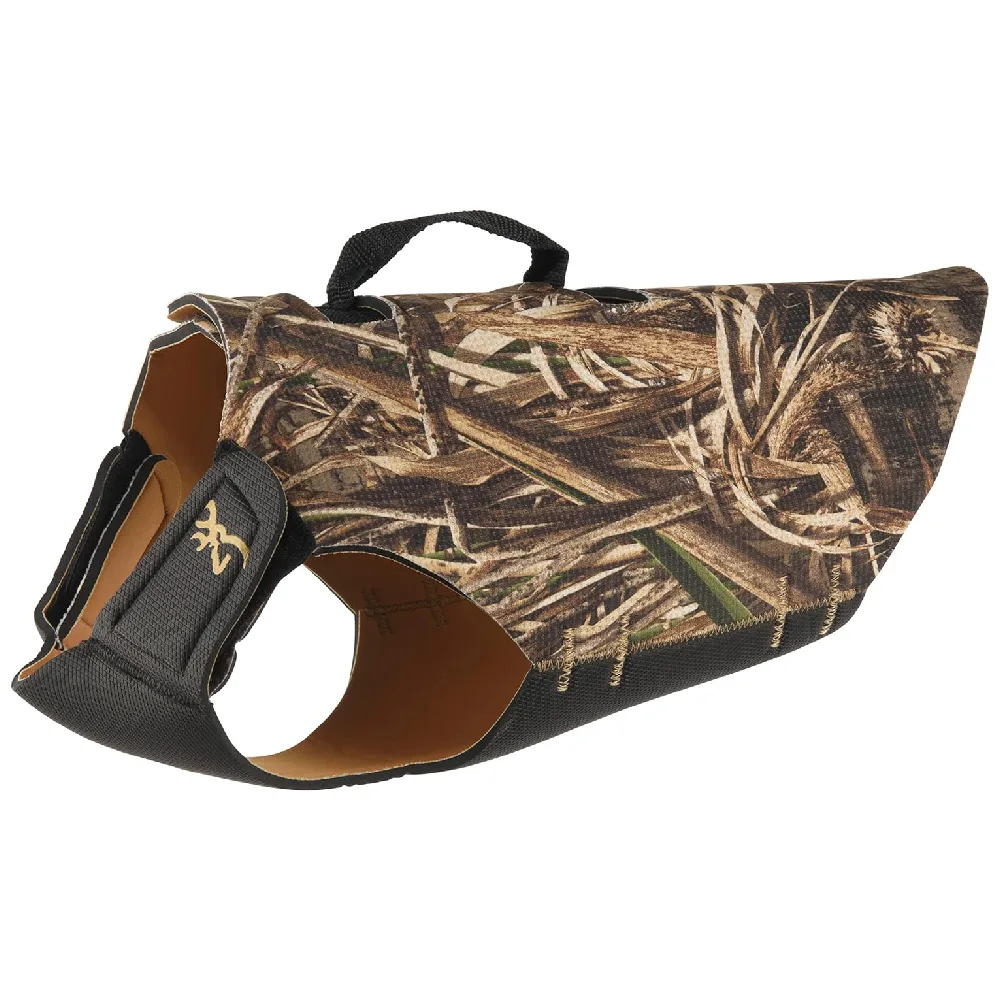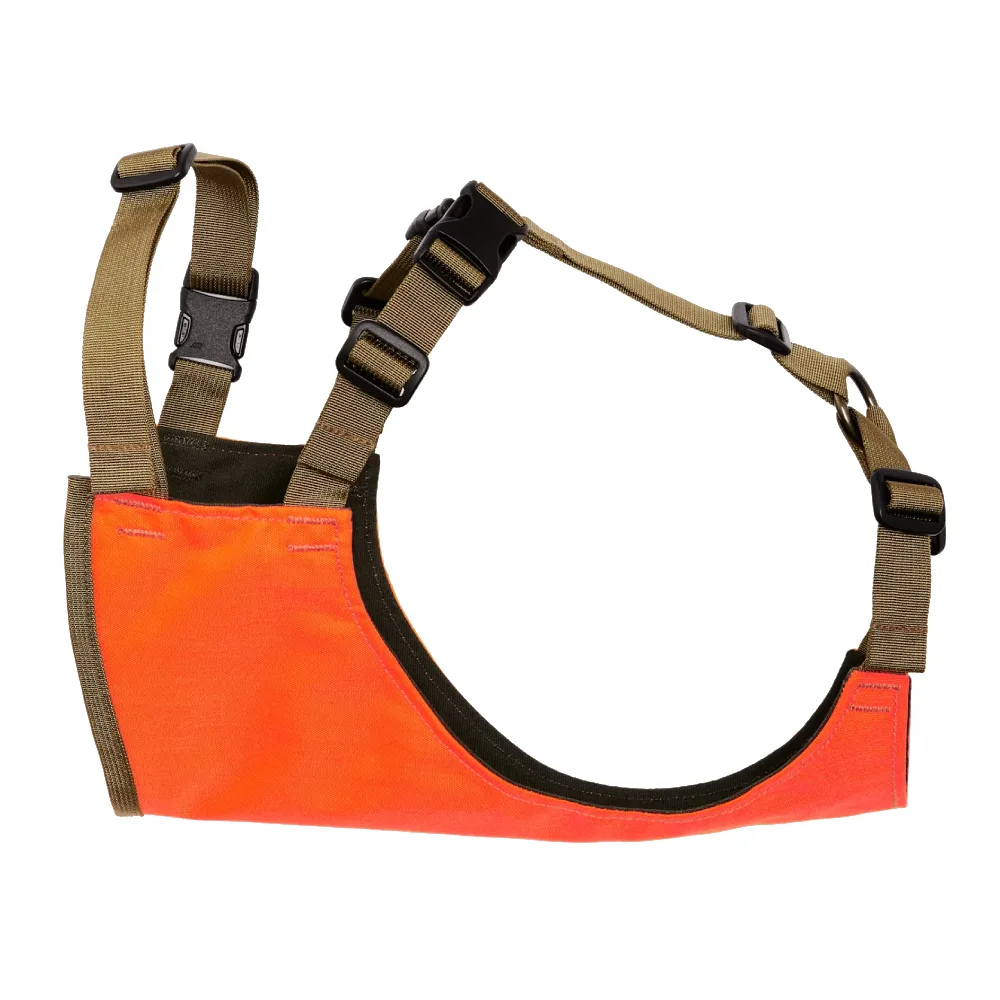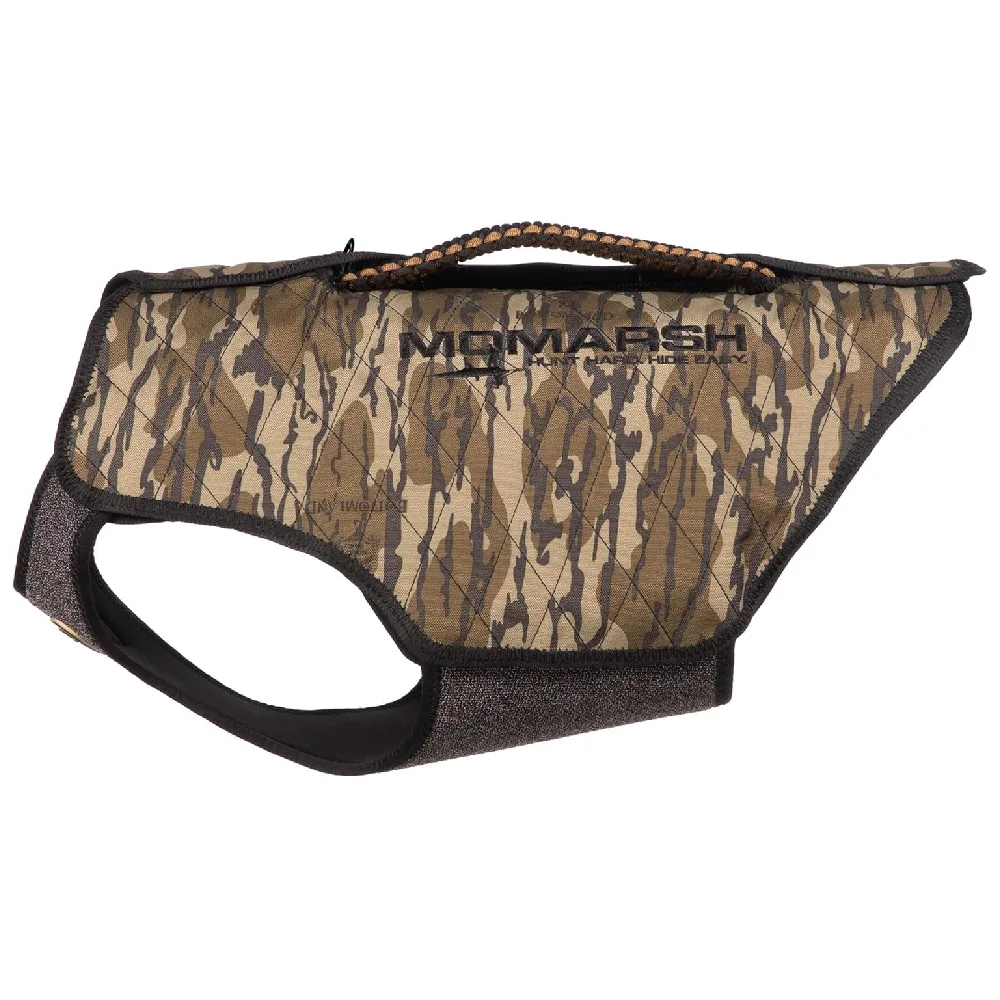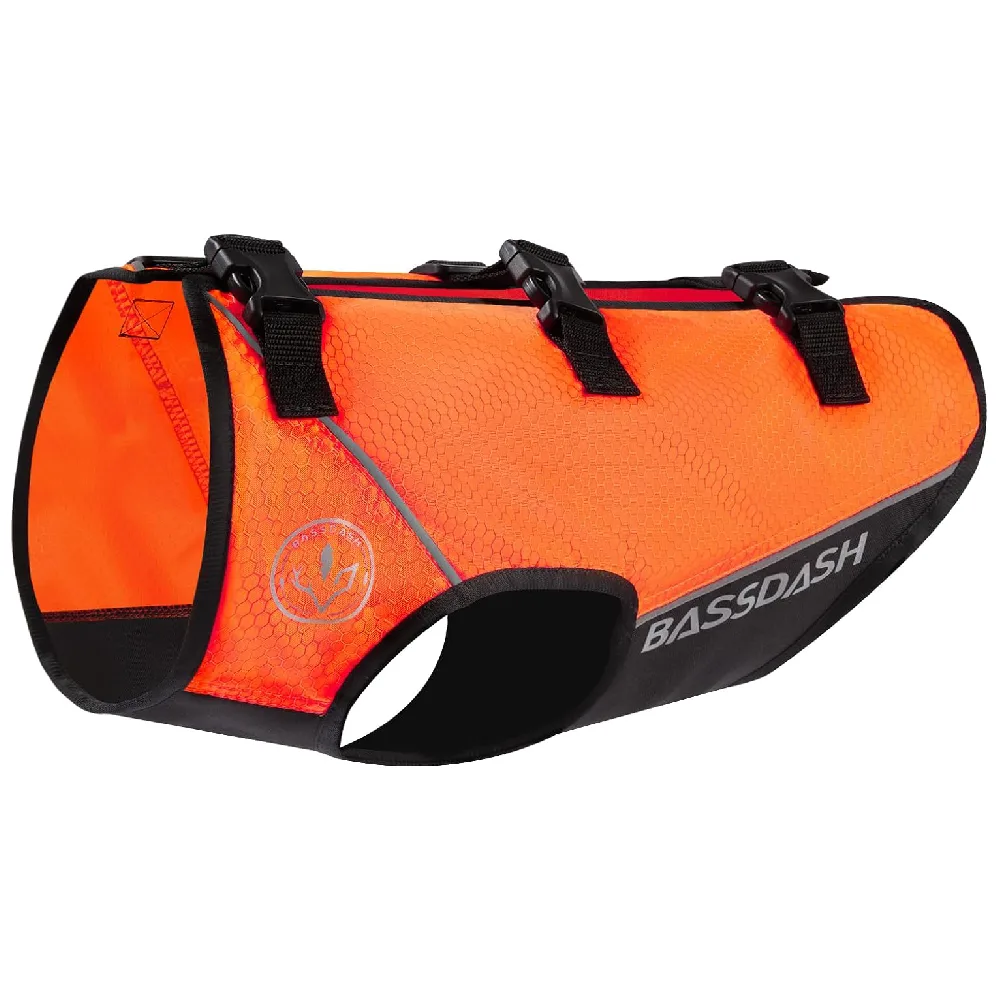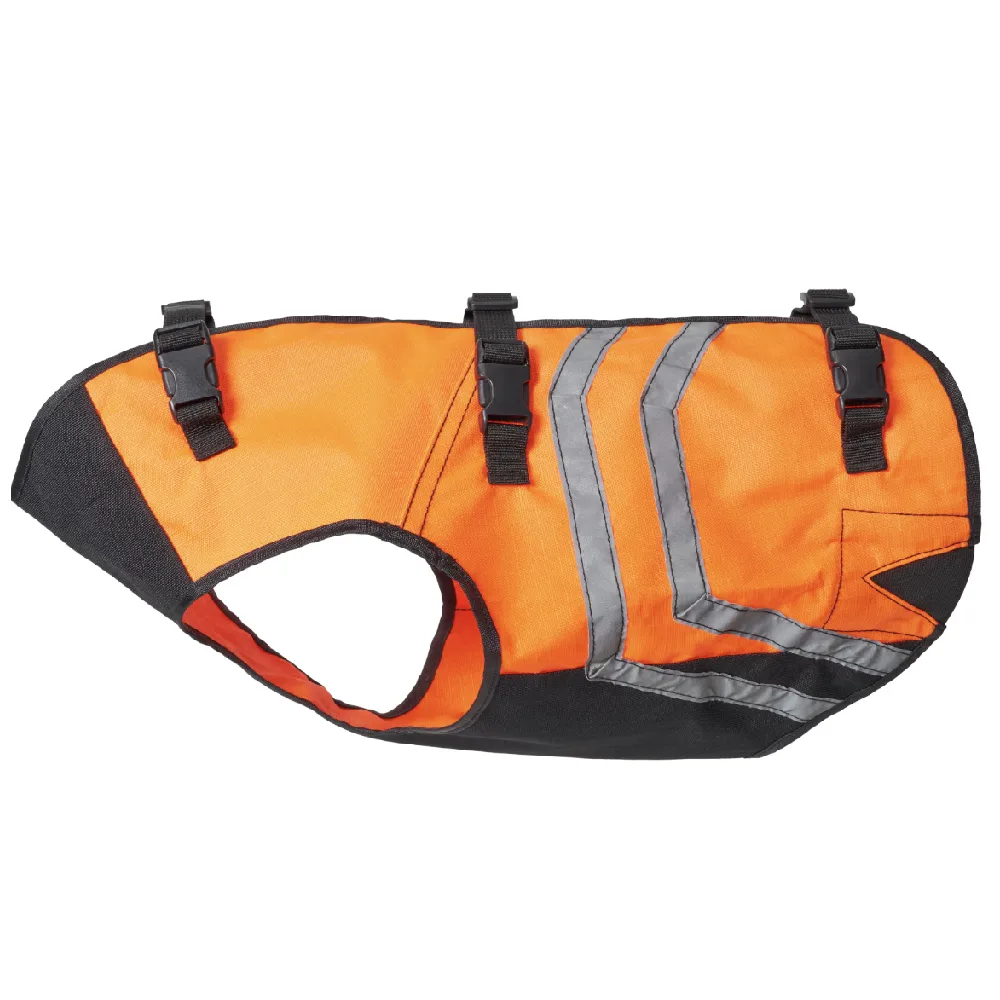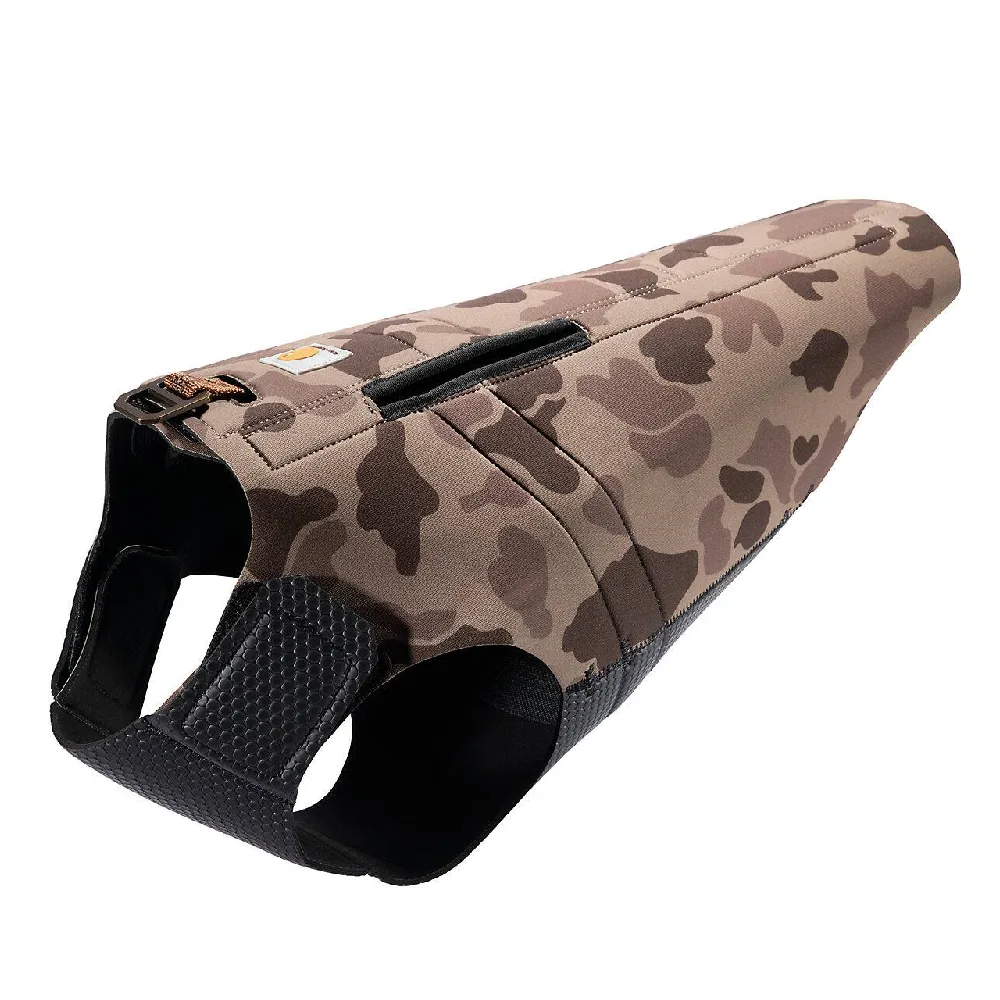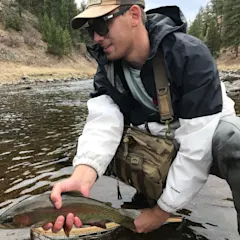We may earn revenue from the products available on this page and participate in affiliate programs. Learn more ›
A hunting dog vest serves a lot of purposes, whether you're upland or waterfowl hunting. It keeps your beloved pup comfortable and, more importantly, safe. Not only can a good vest protect your hunting dog from icy cold water, briars, or other environmental hazards, it can also make them more visible to other hunters (or, in the case of duck hunting, more concealed to birds).
The right vest for your needs depends on what type of hunting you do. Neoprene vests that keep retrievers warm and buoyant are too hot for all but the coldest, wettest upland hunting, and camo only makes a dog harder to see. Blaze orange vests that help you keep track of your bird dog and protect its skin are totally inappropriate for the duck blind. In addition to choosing the right type of vest, you have to make sure it adjusts to fit your dog so there is no chafing or rubbing. We tested out some of the most popular options on our own pups to narrow the best hunting dog vests overall below.
Best Overall: CUGA Vest
Best Blaze Orange: Filson Dog Chest Protector
Best for Duck Hunting: Rig‘Em Right Bloodline Elite Vest
Best Neoprene: Browning Neoprene Vest
Best Adjustable: MOMarsh VersaVest Dog Vest
Best Budget: BassDash Dog Safety Vest
Best Budget Upland: Cabela’s Ripstop Dog Vest
Best Budget Retriever: Carhartt Neoprene Vest
Best Overall: CUGA Vest
Specs
Material: 1,000 denier nylon
Color: Black/Orange or Coyote/Orange
Sizes: XS-XL (regular and narrow widths)
Pros
Lightweight yet tear-resistant
Easily adjustable
Sleek design
Machine-washable
Made in the USA
Cons
Pricey
Not blaze orange
Cuga makes one heck of a vest for hunting dogs. Cuga Vests are made of 1000 Denier Cordura, which is known to be one of the most tear-resistant fabrics out there, meaning your dog won’t get cut up by underbrush and have added protection against barbed wire. At the same time, Cordura is a particularly lightweight fabric, so your dog won’t overheat on early-season hunts.
Cuga’s vests are simple but sleek in design. They provide chest and full-body protection for your dog and are secured with a simple Velcro strap on the top—which, unlike some brands’ straps, won’t get hung up on branches or other obstacles.
Cuga vests are also particularly versatile. While these are ideal for upland hunters and typically come with a high-vis design, the brand does offer a camo waterfowl version, which would be best for dry field hunters. Additionally, the brand offers important size variations, including a narrow option, which means you will likely be able to find an option for any breed of gun dog. In a world in which most vests are geared to fit labs and labs only, this adaptability is crucial for hunters with different breeds.
Best Blaze Orange: Filson Dog Chest Protector
Specs
Materials: Acrylic Ten Mile Cloth and Antique Tin Cloth
Color: Blaze Orange
Sizes: M-XL
Pros
Simple and effective
High visibility
Tough fabric
Prevents overheating
Cons
Bulky straps
Expensive
Filson’s Dog Chest Protector is not technically a “vest,” but it does what any good upland hunting dog vest should do: it protects your hunting buddy’s vital areas from abrasions from barbed wire and brush, and it keeps them visible in the field.
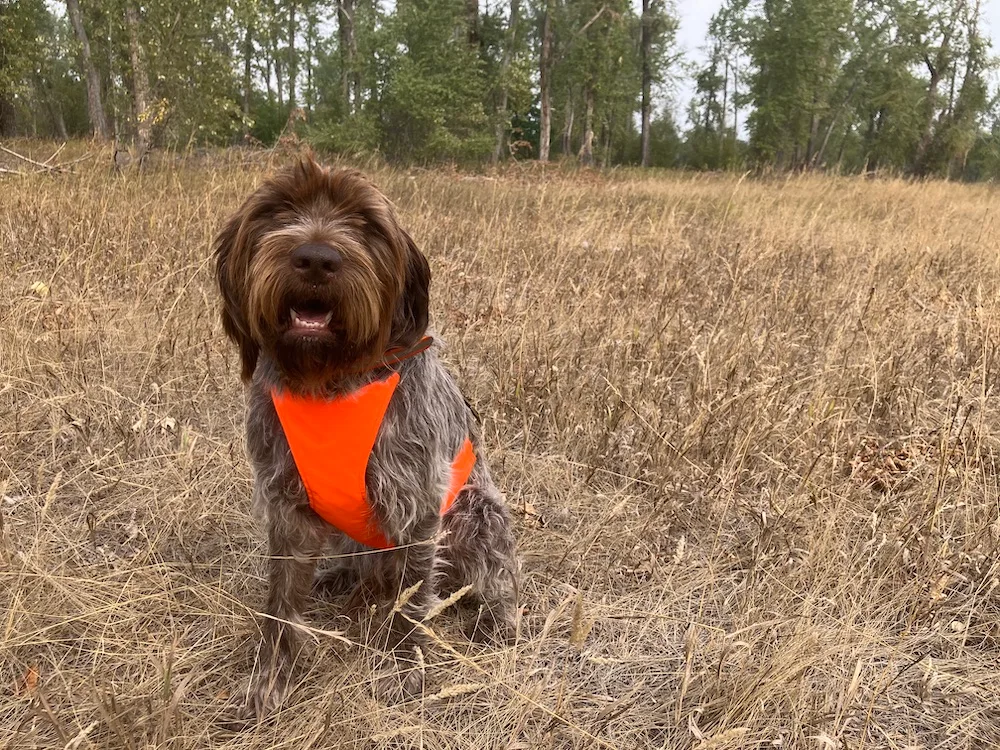
Filson is known for its use of high-quality fabric. This is demonstrated by the brand’s chest protector, which is made with a blend of acrylic cloth with a layer of antique tin cloth, making the chest protectors one of the more heavy-duty options on the market when it comes to abrasion-resistance. Additionally, because the protectors have open backs, it keeps your dog from overheating. The blaze orange is crisp and highly visible.
In terms of drawbacks, the chest protectors carry a high price tag. But my biggest qualm with them was the bulkiness of the back straps. The chest protectors are fine when your dog is hunting knee-high grass and straightforward cover, but the straps get easily hung up in nastier brush — which most bird dogs inevitably hunt.
Best for Duck Hunting: Rig‘Em Right Bloodline Elite Vest
Specs
Materials: Neoprene and foam
Color: Optifade Timber or Marsh, Mossy Oak Habitat, White
Sizes: S-XXL
Pros
Burly construction
Sturdy paracord handle for hoisting your dog into a boat
Features flotation to make swims easier
Extra brush protection
Cons
Stiff
The Rig‘Em Right Bloodline Elite Dog Vest has everything you could ask for when you’re considering a waterfowl vest. Primarily, this thing will keep your dog insulated in frigid water. The upper part of the vest has 3mm of neoprene, a layer of foam to aid floatation, and a heavy-duty canvas surface for protection. The bottom of half of the vest has 5mm of neoprene. You’d be hard pressed to find a waterfowl vest with better insulation than this one.

Overall, the Rig‘Em Right Bloodline strikes me as particularly durable. The strapping mechanism uses both a zipper and Velcro, keeping you’re the vest well-secured on your vest. Additionally, the top handle is made with paracord and feels strong in the hand, meaning you never have to worry it will break while you’re scooping your dog out of the water.
The only drawback here is the stiffness, which is largely caused by the three-layer construction of the top-half of the vest. My dog didn’t seem to mind this any—and most hunting dogs won’t—especially when I was sending him on simple water retrieves. The stiffness doesn’t make this ideal for a lot of running on dry land, at least until the vest is broken in.

The vest has an athletic cut to allow full freedom of motion, and it comes in five sizes to fit anything from small Boykin spaniels up to 100-pound Labs. This vest is as warm as it is tough, and works best in cold weather.
Best Neoprene: Browning Neoprene Vest
Specs
Materials: Neoprene
Color: Realtree Max 5
Sizes: S-XXL
Pros
Well insulated
Flexible fabric
More affordable than others we tested
Cons
Awkward velcro strap
Somewhat flimsy handle
The Browning Neoprene vest is a solid choice for a value-minded waterfowl hunter. This product is simple: it’s entirely made of 5mm neoprene, which provides a high level of insulation. The seams are secured with heavy-duty nylon stitching. The top half is covered in a camo pattern to keep ducks from flaring. And you get all of this at a reasonable price point.
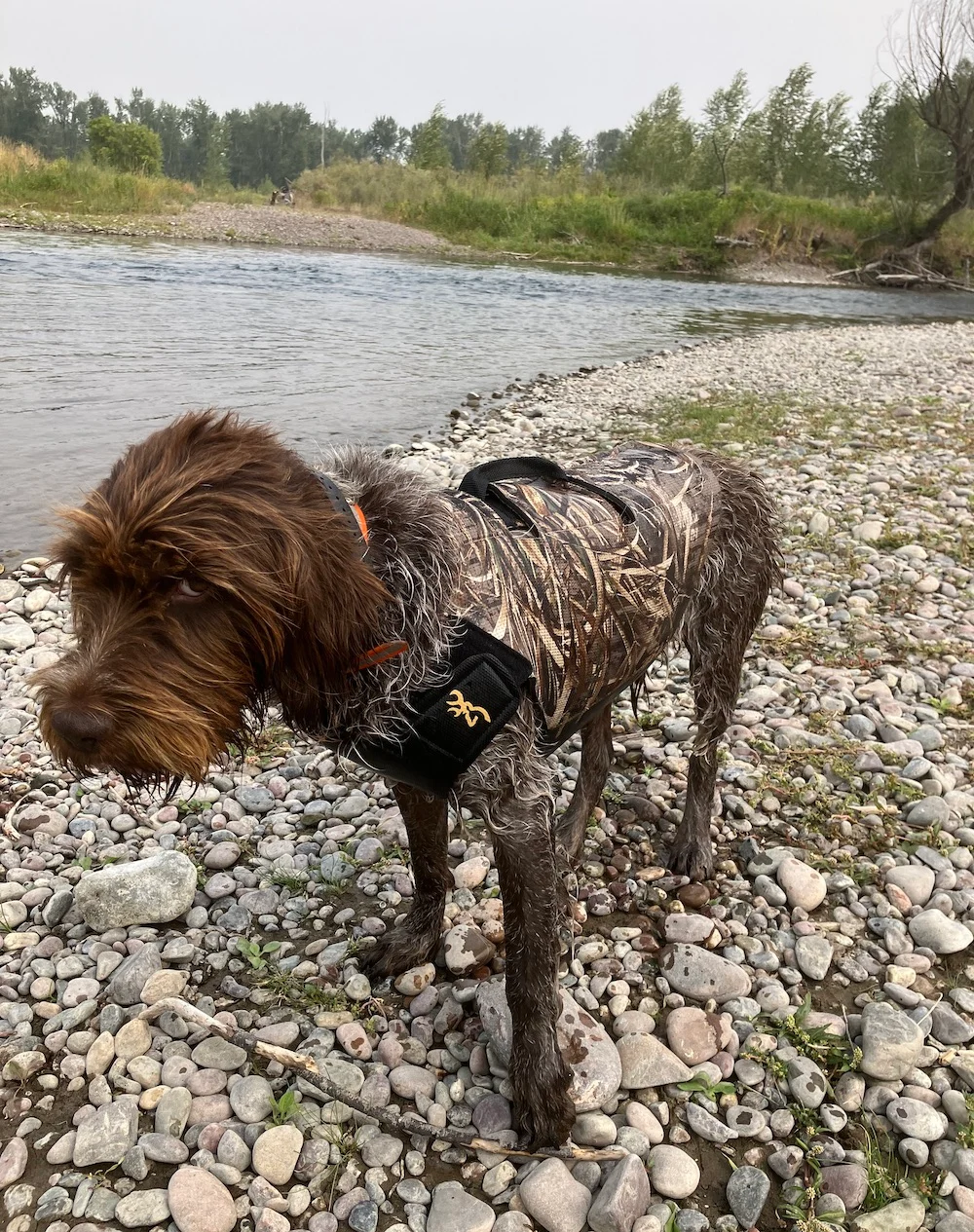
My biggest frustration with this vest is its top. The Velcro strap for the most part makes it easy to affix to the vest to the dog, but one piece of it is supposed to be secured beneath the strap, which makes putting it on the dog an awkward task. The strap, for that matter, could benefit from a heavier construction.
Best Adjustable: MOMarsh VersaVest Dog Vest
Specs
Material: Neoprene with nylon shell
Colors: Optifade Marsh
Sizes: One size fits dogs 35-100 pounds
Pros
Custom fit prevents chafing
One vest fits your dog as it grows
5mm neoprene under 600-denier nylon makes it tough and warm
Cons
Expensive
Assembly required
Designed by a vet and hardcore waterfowl hunter, the VersaVest tackles the problem of fit and chafing with an innovative design that actually lets you build the vest around your dog for the right sizing. You add the outside panels to the Velcro-covered frame, then, once the vest is fully assembled you can leave it that way and use the top opening to put it on and off. In addition to the custom fit, the vest offers plenty of protection with 5mm neoprene insulation and a tough nylon outer shell. There’s also a stow-away handle and leash anchor so you can lift the dog into the boat and leash it or stake it out.
Best Budget: BassDash Dog Safety Vest
Specs
Material: Ripstop fabric
Color: Orange/Black
Sizes: S-XXL
Pros
Dirt cheap
Blaze orange
Adjustable straps
Cons
Thin fabric
Straps easily catch on branches
BassDash makes the most affordable hunting dog vest on the market — and for most upland hunters and their dogs, it will get the job done. This blaze-orange vest will keep your dog field visible in the field and protect against minor cuts, as well as burdocks. It’s also lightweight and cool enough for your dog to run miles in.

Of course, you get what you pay for. The polyester fabric that these vests are made with are thinner than most hunting dog vests, and I doubt it would do much to protect your pup in the case of sharp branches or barbed wire. Additionally, the vest’s straps and latches are made with poor quality plastic and also get caught in branches when working thick cover. These vests aren’t made for waterfowl dogs.
Best Budget Upland: Cabela's Ripstop Dog Vest
Specs
Material: Ripstop nylon
Color: Blaze Orange/Black
Sizes: S-L
Pros
Reinforced chest plate for added protection
Reflective strips for nighttime visibility
Buckle closures in place of Velcro that lose effectiveness
Cons
May be hard to fit on larger dogs
Upland hunters on a budget still get plenty of protection for the dogs with this vest, which combines blaze orange and reflective stripes with a nylon shell that’s reinforced on the bottom with tough 900 denier material. Three sizes and adjustable buckle-closed straps help you find the right fit for your dog.
Best Budget Retriever: Carhartt Neoprene Vest
Specs
Material: Neoprene
Colors: Duck Camo
Sizes: S-XXL
Pros
3mm neoprene is back with extra chest protection
Grab-handle holes and D-ring for a leash
Old school camo with reflective Carhartt logo for nighttime safety
Cons
Lacks flotation
Not as warm as thicker, insulated vests
Carhartt’s vest is affordable workwear for your working dog. The 3mm neoprene offers warmth while extra reinforcement on the chest protects from sharp sticks underwater. A webbing harness inside adds strength and structure so you can lift your dog out of water with the grab-handle holes. There’s also a reinforced D-ring on top so you can leash your dog for safety or if you need to tie a young dog out in the blind to keep it from breaking. In all, this is a vest that is both bare-bones, yet also well-made and well-thought out enough to be functional in the field.
How We Tested Hunting Dog Vests
I spent the last month assessing the best hunting dog vests with the help of my bird dog: a 5-year-old wirehair pointing griffon named Gunney, who wore each vest in the field. As a versatile breed, Gunney hunts both upland and waterfowl, allowing us to get insight on how both types of vests functioned.

Our waterfowl vest testing was done during training sessions as the duck hunting season has yet to open in our home state of Montana. Gunney wore the vests through NAVHDA duck search and steady to blind sequences. For these vests, I assessed Gunney’s comfort level while waiting and swimming with them. I also looked at the durability of each one—would it be able to last for several hunting seasons? Was the fabric thick enough to prevent abrasions when Gunney was searching in thick cattails? Finally, I tested each one’s additional components: Was the strap sturdy enough to safely lift Gunney out of the water and into a duck boat or raised dog blind? Did the camo design help conceal the dog?

As for upland hunting vests, Gunney put them to the test in training sessions and also on early-season hunts both on Montana’s prairies for sharptails and huns and in the mountains for spruce and ruffed grouse. For these vests, it was paramount to see if Gunney was able to stay cool on early season hunts — and also to make sure the fabric helped keep him free of burrs and abrasions. Also of importance was seeing how the vests could be adapted to properly fit him—and prevent heat rash after miles of running. Finally, were the vests visible enough to keep him safe? Here's what we found.
What To Look for in a Hunting Dog Vest
Obviously, the first decision you have to make when you buy a dog vest is what type of vest you need. Will your dog hunt ducks or upland birds, or some of each? A dog that plunges into icy water, then sits still for some time, needs a much warmer vest than a dog that will be hunting in the uplands, constantly moving, and not getting wet. And, while camo is a good choice in the duck blind, an orange vest that keeps your dog visible to you, other members of your party, and firearms deer hunters makes much more sense for upland hunting.
If you’re choosing a vest for a water dog, you can find neoprene models made of thick 5mm material for added insulation, or lighter 3mm for milder conditions. Some vests even have added flotation to make swimming easier and keep your dog from tiring out.
Upland vests also offer varying levels of protection which you have to balance with weather conditions. Overheating can be even more dangerous to a dog than sticks and barbed wire. Reflective strips on a vest can give you peace of mind, too, if you worry that your dog might wind up on a road at night, be sure to choose a model with reflective strips.
Just as important as what kind of vest you buy, it’s important to get the size right. Be sure to measure your dog and choose the right size, and look for a vest that can be adjusted or can be trimmed to fit your dog.
FAQs
Q: Does my hunting dog need a vest?
A hunting dog needs a vest in several situations to keep it safe and healthy. Retrievers working in cold weather need a vest to help them stay warm. In between swims in the cold water, the dog is expected to sit still, so it won’t be able to run around and keep itself warm. That said, even if the dog is wearing a vest, you need to watch it for signs of hypothermia like sluggish movements and excessive shivering. A sturdy vest will also protect a retriever from ice and underwater sticks.
Upland hunting dogs need hi-vis vests to help them stay safe and visible during firearm gun seasons. On the underside, hard-charging dogs and nursing females require the chest and belly protection that a vest affords. Dogs coming back into the field after stitches might need the protection of a vest as well. And in very cold, wet conditions, even an upland dog could stand to wear a neoprene vest in the field.

Q: How do you measure a dog for a hunting vest?
Each brand that makes hunting dog vests does sizing a little bit differently, so you should always consult that company’s recommendations before pulling the trigger on a purchase. That said, you will need to use a soft measuring tape on your dog, typically to measure the size of its chest just behind the front legs. Some companies also will ask you to measure the distance between the dog’s front legs to make sure the vest won’t cause a heat rash on the undersides of their front legs.
Q: How do I get my dog to wear a vest?
It’s not rocket science: put the dog in the vest and do some fun training or hiking with it so it associates the vest with good things. The dog will gain comfort with the vest the more it wears it. Make sure to familiarize your dog to the vest before you actually go hunting so it’s one less variable to worry about when you’re in the field trying to kill birds.
Final Thoughts
Choosing the best hunting dog vest means taking the needs of your dog, and the hunting you’ll do with it, into account. Vests for retrievers keep them warm, dry and can provide flotation to help the dog keep working longer. They can also shield your retriever from jagged ice and sticks in the water. An upland vest can protect a dog’s chest and belly from wire, sticks, briars and other hazards in the field. The bright orange color makes it easier to keep track of your dog, and it can make it visible to firearms deer or predator hunters. As important as getting the right vest for your dog’s needs is, you have to be sure it fits properly. It makes no sense to buy a vest to protect a dog if that same vest rubs them raw. Hard-working dogs may run through a vest in a couple of seasons but even so, the right hunting dog vest is a sound investment in your pup’s safety.
Why Trust Us
For more than 125 years, Field & Stream has been providing readers with honest and authentic coverage of outdoor gear. Our writers and editors eat, sleep, and breathe the outdoors, and that passion comes through in our product reviews. You can count on F&S to keep you up to date on the best new gear. And when we write about a product—whether it’s a bass lure or a backpack—we cover the good and the bad, so you know exactly what to expect before you decide to make a purchase.

